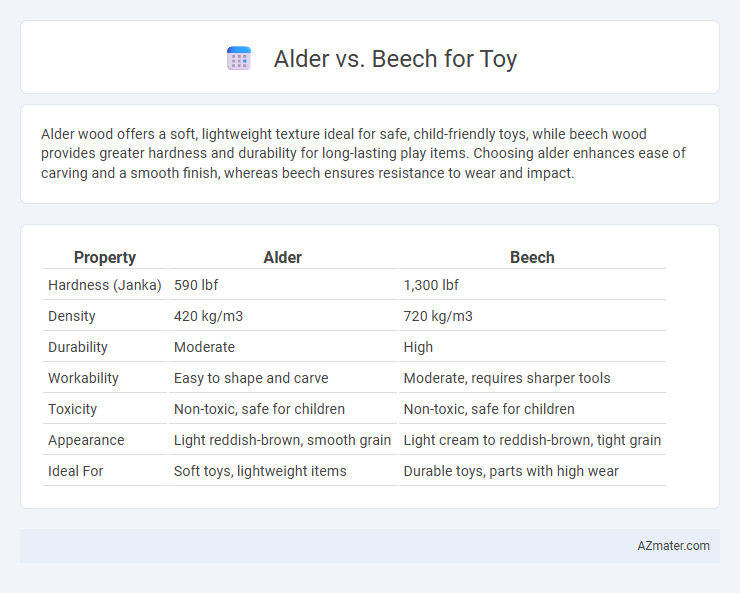Alder wood offers a soft, lightweight texture ideal for safe, child-friendly toys, while beech wood provides greater hardness and durability for long-lasting play items. Choosing alder enhances ease of carving and a smooth finish, whereas beech ensures resistance to wear and impact.
Table of Comparison
| Property | Alder | Beech |
|---|---|---|
| Hardness (Janka) | 590 lbf | 1,300 lbf |
| Density | 420 kg/m3 | 720 kg/m3 |
| Durability | Moderate | High |
| Workability | Easy to shape and carve | Moderate, requires sharper tools |
| Toxicity | Non-toxic, safe for children | Non-toxic, safe for children |
| Appearance | Light reddish-brown, smooth grain | Light cream to reddish-brown, tight grain |
| Ideal For | Soft toys, lightweight items | Durable toys, parts with high wear |
Introduction to Alder and Beech Wood
Alder wood, known for its light weight and fine grain, offers excellent workability and smooth finishing, making it ideal for crafting toys that require detailed shaping and a lightweight structure. Beech wood is dense, hard, and highly durable with a tight grain, providing robust strength and a smooth surface, perfect for toys that need to withstand rough play and prolonged use. Both woods are non-toxic and safe for children, but alder's softer texture makes it easier to carve, while beech's hardness ensures longevity.
Physical Properties Comparison
Alder wood is lightweight with a Janka hardness of 590, offering moderate durability suitable for children's toys. Beech wood is denser, with a Janka hardness of 1300, providing greater strength and resistance to wear, ideal for long-lasting, robust toys. Both woods have fine, even grains, but Beech's tighter grain enhances its smooth finish, making it preferable for toys requiring intricate shaping and durability.
Safety and Non-Toxicity for Toys
Alder wood is favored for toys due to its natural softness and low resin content, which reduces the risk of splinters and ensures a safer, non-toxic surface for children. Beech wood, though harder and more durable, is also non-toxic and commonly used in toy manufacturing, but requires careful sanding to avoid splinters. Both woods meet safety standards for children's products, yet alder's gentler texture often makes it the preferred choice for toys intended for younger kids.
Durability and Strength Factors
Alder wood is softer and less dense than Beech, resulting in lower durability and strength for toy construction. Beech offers superior hardness and resistance to wear, making it ideal for toys that require long-lasting durability and structural integrity. The fine, tight grain of Beech enhances its strength, providing a sturdy material that withstands rough handling better than Alder.
Workability and Crafting Ease
Alder wood features a fine, even texture and low density, making it highly workable and ideal for toy crafting due to its ease of cutting, shaping, and sanding. Beech offers a harder, denser grain that demands more effort during carving but provides excellent durability and smooth finishing for long-lasting toys. The choice between alder and beech depends on balancing ease of craftsmanship with desired strength and finish quality in toy construction.
Appearance and Aesthetic Qualities
Alder wood exhibits a warm, reddish-brown hue with a smooth, consistent grain pattern, making it ideal for toys that require a soft, natural look. Beech wood features a pale, creamy color with a fine, tight grain that provides a clean and uniform appearance, enhancing the aesthetic appeal of crafted toys. Both woods offer visually pleasing finishes, but Alder's richer tones give toys a more rustic charm, while Beech's lighter coloration lends a modern, minimalist style.
Sustainability and Environmental Impact
Alder wood is highly sustainable due to its fast growth rate and ability to regenerate quickly, making it an eco-friendly choice for toy manufacturing. Beech wood, while durable and hard, requires longer growing periods and more intensive forestry management, leading to a higher environmental impact. Choosing alder for toys reduces deforestation pressure and supports sustainable forestry practices.
Cost and Availability
Alder wood is generally more affordable and easier to source for toy manufacturing compared to beech, making it a popular choice for cost-conscious producers. Beech offers superior hardness and durability but typically comes at a higher price and may have limited availability depending on the region. Toy makers often balance cost efficiency with material properties by selecting alder for budget designs and beech for premium, long-lasting toys.
Popular Uses in Wooden Toys
Alder wood is favored in wooden toys for its soft texture, easy workability, and smooth finish, making it ideal for detailed carving and safe for children's handling. Beech wood is popular due to its hardness, durability, and resistance to wear, offering long-lasting strength for robust toys like building blocks and puzzles. Both woods are non-toxic and can be sustainably sourced, aligning well with eco-friendly toy production standards.
Choosing the Right Wood for Your Toy Project
Alder wood offers a smooth texture and light weight, making it ideal for toys that require easy handling and detailed carving. Beech wood provides superior durability and resistance to wear, perfect for robust toys intended for long-term play. Selecting the right wood depends on balancing softness for safety and hardness for durability to ensure both child-friendly and lasting toy projects.

Infographic: Alder vs Beech for Toy
 azmater.com
azmater.com